Tähtitieteellinen yhdistys Ursa
Ilmakehän optiset ilmiöt

Displays
6.4.
A depression above the Barents Sea was responsible for producing some cirrus. In Central Europe, the back of the departing low pressure area gave some showers and halos. The remaining areas were covered by an anticyclone, where the clouds merely evaporated. Richard Löwenherz reported the circumzenithal arc, and a bit later, the parhelia presented with considerably beautiful drawing.
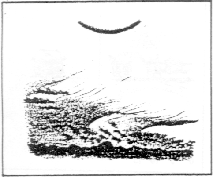
Satellite image: Apr 6, 12:36 GMT
7.4.
A high pressure ridge extended from Central Europe as far as Central Scandinavia. The north of Finland got a few halo clouds - the forerunner of a Russian warm front - that brought some small quality halo activity. A warm front from the one low pressure area between Greenland and Ireland approached the British Islands, from where halos were detected in advance of the front.
The leading cirrus brought some halos for the Netherlands. As a highlight (literally fine light high up) of the day Frank Nieuwenhuys witnessed a sophisticated display in the Hague, Netherlands. Frank saw a very sharp and colourful Parry arc and according to him a possible 120° parhelion at the end of a long parhelic circle.
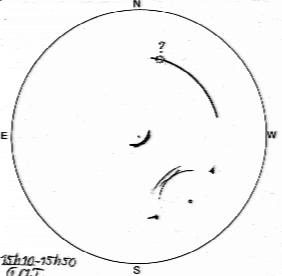
Satellite image: Apr 7, 12:26 GMT
8.4.
The warm front drifted across Eastern Scandinavia and Northern Holland, and later Northern Germany. It brought plenty of cirrus and many halos to large parts of Central Europe, and even some halos in gaps in the lower clouds for Finland. Berthold, for example, captured a perfectly developed 22° halo ring at noon. Not so ordinary as one might tend to think at first, for how many times have you yourself seen the full circle this year?
At Deventer, the Netherlands Hattinga Verschure received a collection of 22° area halos in the evening time ...as if promising something, but it didn't get better. Across the border in South, in Belgium the uppermost part of the 22° halo was seen by Karin Hamid in Tielt.
Over Britain, there was the trailing cold front of the North Atlantic low pressure region. Here too 22° area halos were visible as indicated by the drawing by Les Cowley - A diffuse 22° halo in an all-sky cirrus layer.
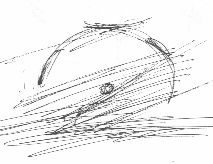
Satellite image: Apr 8, 12:15 GMT
This cold front drove north of Central Europe, and the cirrus ahead of it brought a halo invasion. In Eastern Finland the cold and warm fronts became occluded, and brought some halos to Finland as well. Large amount of observations in Central Europe.
Peter-Paul Hattinga Verschure discerns with an interesting pyramidal display in the early afternoon in Deventer, the Netherlands. Using a mirror, Peter-Paul noticed faint traces of a colourless 9° halo. As Peter-Paul also himself speculated, the upper arc that resembles the 22° upper tangent arc might have been the 23° parroid (23° parhelion). The ring halo at its turn, is very difficult to subsequently identify; it might for example be an aggregate of 22° and 23° rings. This type of combination seems to have the highest frequency within all kinds of pyramidal displays. His colleague at Woensdrecht, Menno van der Haven had his best display of April also on 9th, but it was limited to non-pyramidal, but well developed 22° area forms. Leo Eijkelenboom at Waalre had a similar fate: the dist display of April and again restricted to 22° area. ..and the same is with Fred Roovers who observed, e.g., beautifully developed 22° tangent arcs in Zaandam. Stefan Jak caught on some better material as either a long tailed parhelion or a parhelic circle was also evident at his location in Zwolle. The display was visible again from Belgium as well, where attention was paid to a "long lasting" 22° upper tangent arc, which often is a sign of plenty of halos some time during the day. Belgian observation came from Hamid and Jürgen Buelens. It appears that 9th was special in the Benelux countries, but the show is completely stolen by Germans.
An extraordinarily long-lived complex display was recorded in Chemnitz by Berthold. A faint Parry showed up already at 08:35 GMT. One peak of the display was at noon, as the perfectly developed parhelic circle encircled the sky, with both the 120° parhelia and a circumscribed halo, fully developed as well, present. The second strong peak was in the late afternoon, showing a very nice complex display with, for example, the Parry arc.
Specially interesting in regard of this day are the short arcs drawn by Gerald to tangent the 46° region halo (see the picture) at about 10 and 14 o'clock. The shape of the 46° supralateral arc at these solar elevations is too far from the short arcs to provide a correct explanation. No convincing photographs are known among the research community of the alleged 46° contact arcs (Galle arcs) that sometimes are suggested to account for this kind of observations. The somewhat strong Parry gives an intriguing hint; maybe the short arcs were the rare Tape arcs that sometimes may be seen as enhancements on the 46° supralateral arc. Newest information from Chemnitz headquarters as heard in telephone from Claudia Hetze tell that in a recent, a bit similar display (seen in September) the rare Tape arcs were indeed photographed by Gerald. However in the April display the arcs might have been the much more usual 46° supralateral arcs according to the Chemnitz sources.
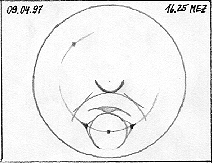
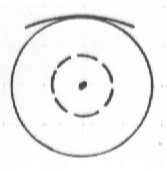
In Heidelberg, Germany Gunnar Hering enjoyed a big non-pyramidal display with a Parry arc and a one-sidedly developed parhelic circle. The 120° parhelion was accompanied by a brightening farther away. None of the old literature sun dog candidates are fruitful to consider as explanations. There is one historical sun dog candidate pretty much for all the degree distances, but their intensities are either too low to show up in modern day supercomputer simulations or the crystals on which they were suggested in the turn of the century have not been found from nature to this day) it might have been the Liljequist parhelion (150°-160°) or a crystal swarm intensification. Photographs would give valuable help in the analysis of interesting cases like this one.
Excitingly the display was partially seen in Austria as well, where Karl Kaiser followed its long evolving in Schlägl. At his location among others Parry and 46° infralateral arc had been lit in the sky.
Hartmut Bretschneider got perhaps the best part of the display, in Schneeberg, Germany. The peak was definitely at 16:30 GMT, when even a faint upside-V pattern showed up in the anthelion region! At these solar elevations and with this rare and exquisite type of "upside down V" it is typical that the Greenler's diffuse anthelic arcs were in question. There were extraordinarily many anthelic arc observations in Central Europe in April, which was a delightful surprise to our Southern colleagues. Even in Finland Greenler's anthelic arcs are not received every year. Particularly this year all anthelic arcs, even the most frequent Wegener's turned out to be very scarce. Special congratulations go naturally to Hartmut, who had one of very best stuff in Europe this April.
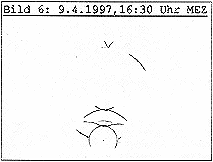
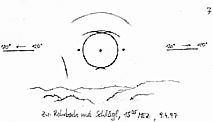
Satellite image: Apr 9, 12:04 GMT
10.4.
A low pressure area, which developed the day before on the west coast of Norway, sent its warm front to Central Europe, and again produced some halos there. In England some halos appeared in advance of the trailing cold front. Both fronts became occluded over South Finland and caused a few halos there too. In Schlägl, Austria, Karl Kaiser drew the 22° halo, glimmering at the morning frost. Look for these "surface halos" during the cold season! Not only the 22° and 46°, but also other halos, for example the subparhelia, might come up on snow or frost surfaces.
Both of the main rings, i.e., the 22° and 46° ones were encountered by Ludger Ihlendorf in Damme in the morning, this time in the upper cloud.
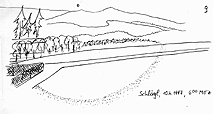
Satellite image: Apr 10, 11:53+13:33 GMT
10./11.4.
In Chemnitz, Germany Claudia Hetze adorns a lunar 22° halo or vice versa. The rest of Europe is quiet of halos. This year the Germans successfully took both the first and the last lunar halos seen in April. This particular victory chain was started by Claudia and finished by Gerhard Stemmler on the night between 26/27.4.
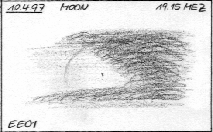
-
 Useita halomuotoja II 2.1.2026 klo 20.34; Nivala; Heli Ojalehto
Useita halomuotoja II 2.1.2026 klo 20.34; Nivala; Heli Ojalehto -
 Harvinaisia halomuotoja IV 2.1.2026 klo 19.00; Oulu; Marja Marttila
Harvinaisia halomuotoja IV 2.1.2026 klo 19.00; Oulu; Marja Marttila -
 Useita halomuotoja II 2.1.2026 klo 19.00; Raahe; Irina Jylhä
Useita halomuotoja II 2.1.2026 klo 19.00; Raahe; Irina Jylhä -
 Yksi halomuoto I 2.1.2026 klo 18.00-18.01; Haapavesi; Osmo Hyvärinen
Yksi halomuoto I 2.1.2026 klo 18.00-18.01; Haapavesi; Osmo Hyvärinen -
 Useita halomuotoja II 2.1.2026 klo 13.00-13.10; Kajaani; Mervi Juntunen
Useita halomuotoja II 2.1.2026 klo 13.00-13.10; Kajaani; Mervi Juntunen -
 Useita halomuotoja II 2.1.2026 klo 12.30-14.00; Raahe; Mikko Silvola
Useita halomuotoja II 2.1.2026 klo 12.30-14.00; Raahe; Mikko Silvola -
 Useita halomuotoja II 2.1.2026 klo 11.00-14.00; Raahe; Irina Jylhä
Useita halomuotoja II 2.1.2026 klo 11.00-14.00; Raahe; Irina Jylhä -
 Keinovalopilareita II 2.1.2026 klo 2.00-3.00; Kempele; Marko Haapala
Keinovalopilareita II 2.1.2026 klo 2.00-3.00; Kempele; Marko Haapala
-
 Yksi halomuoto I 2.1.2026 klo 0.27; Parkano; Soili Jalava
Yksi halomuoto I 2.1.2026 klo 0.27; Parkano; Soili Jalava -
 Harvinaisia halomuotoja IV 2.1.2026 klo 0.25-4.10; Vaasa; Timo Alanko
Harvinaisia halomuotoja IV 2.1.2026 klo 0.25-4.10; Vaasa; Timo Alanko -
 Yksi halomuoto I 2.1.2026 klo 0.05-0.15; Kauhajoki; Anu Kilpiö
Yksi halomuoto I 2.1.2026 klo 0.05-0.15; Kauhajoki; Anu Kilpiö -
 Useita halomuotoja II 1.1.2026 klo 22.50-23.30; Seinäjoki; Pekka Lähteenmäki
Useita halomuotoja II 1.1.2026 klo 22.50-23.30; Seinäjoki; Pekka Lähteenmäki -
 Keinovalopilareita 1.1.2026 klo 22.00-22.30; Oulu; Ari Juntunen
Keinovalopilareita 1.1.2026 klo 22.00-22.30; Oulu; Ari Juntunen
-
 Useita halomuotoja II 1.1.2026 klo 22.00 - 2.1.2026 klo 7.00; Vaasa; Juha Varis
Useita halomuotoja II 1.1.2026 klo 22.00 - 2.1.2026 klo 7.00; Vaasa; Juha Varis -
 Yksi halomuoto I 1.1.2026 klo 21.47; Simo; Joni Alavesa
Yksi halomuoto I 1.1.2026 klo 21.47; Simo; Joni Alavesa
![[EHP]](fileadmin/_migrated/RTE/RTEmagicC_664970cc8d.gif.gif)
